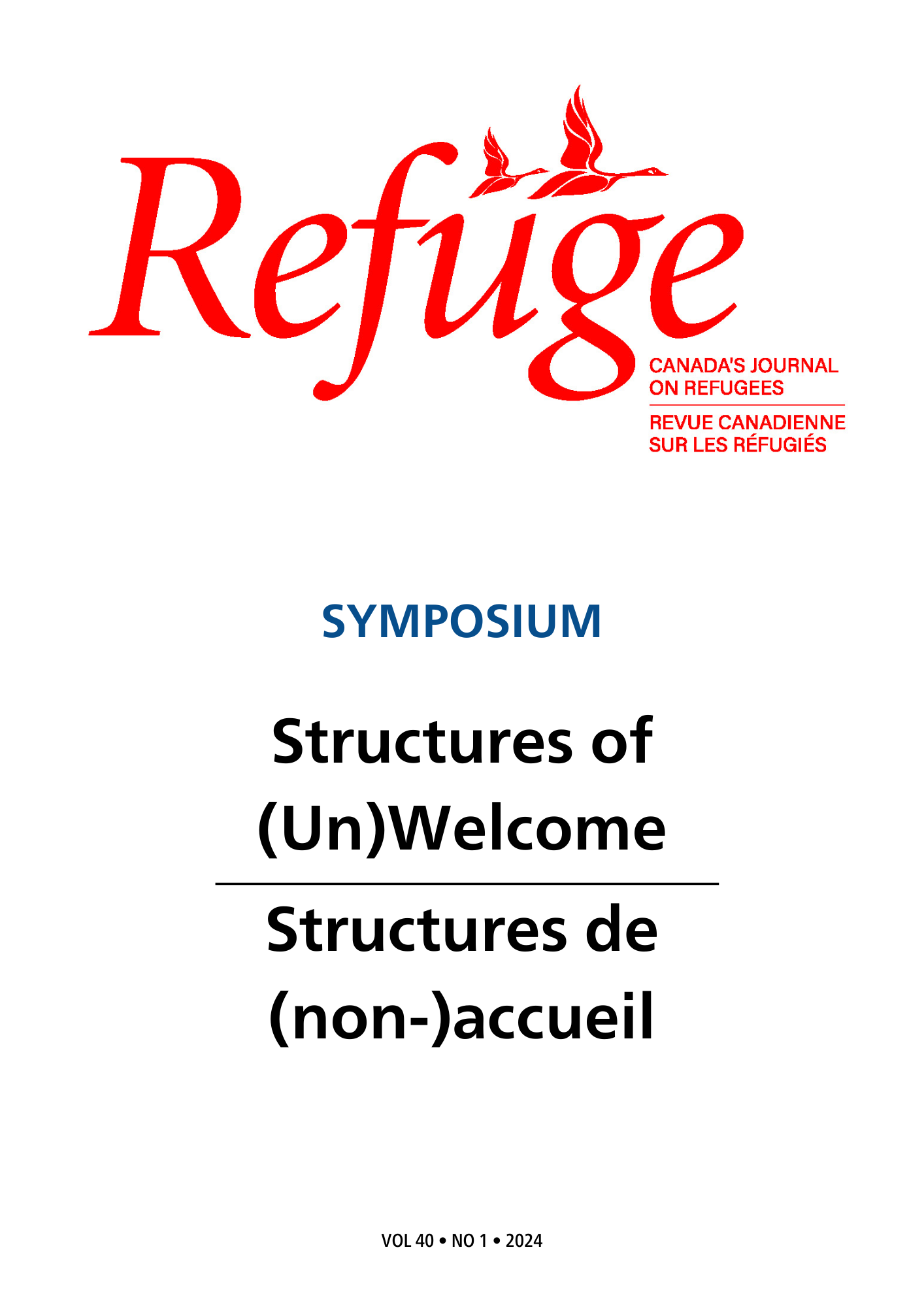Claim Types in Canada’s Refugee Determination System
An Empirical Snapshot (2013–2021)
DOI:
https://doi.org/10.25071/1920-7336.41139Keywords:
Canada, refugee law, empirical, quantitative, political opinion, gender, sexual orientation, religion, race, ethnicityAbstract
This article overviews outcomes in different types of refugee claims in Canada. It critiques standard legal research methodologies in the refugee law field due to skews in publication practices. To address these skews, the article employs empirical quantitative research methods using administrative tribunal data and computational methods. It provides a snapshot of refugee claim numbers, countries of origin, claim categories, and outcomes. The article then underscores the benefits of supplementing doctrinal legal research with empirical quantitative research methods, outlines barriers to the adoption of such methods, and offers guidance and tools to assist other researchers in overcoming those barriers.
Metrics
References
Access to Information Act, R.S.C., 1985, c. A-1, s. 19(1).
Alarie, B., & Aidid, A. (2023). The legal singularity: How artificial intelligence can make law radically better. University of Toronto Press.
Arbel, E. (2013). The culture of rights protection in Canadian refugee law: Examining the domestic violence cases. McGill Law Journal, 58(3), 729–771. DOI: https://doi.org/10.7202/1018394ar
Atak, I., Alroh, Z. A., & Ellis, C. (2021). Expanding refugee ineligibility: Canada’s response to secondary refugee movements. Journal of Refugee Studies, 34(3), 2593–2612. https://doi.org/10.1093/jrs/feaa103 DOI: https://doi.org/10.1093/jrs/feaa103
Bains v. Canada (Minister of Employment and Immigration), (1990) 47 Admin LR 317.
Bhuyan, R., Vargas, A., & Píntín-Perez, M. (2016). Fleeing domestic violence from a “safe” country? Refugee determination for Mexican asylum-seekers in Canada. Refuge: Canada’s Journal on Refugees, 32(3), 95–107. https://doi.org/10.25071/1920-7336.40373 DOI: https://doi.org/10.25071/1920-7336.40373
Blender, E., Gebru, T., McMillan-Major, A., & Shmitchell, S. (2021). On the dangers of stochastic parrots: Can language models be too big? In FAccT ’21: Proceedings of the 2021 ACM Conference on Fairness, Accountability, and Transparency (pp. 610–623). Association for Computing Machinery. https://doi.org/10.1145/3442188.3445922 DOI: https://doi.org/10.1145/3442188.3445922
Cameron, H. E. (2018). Refugee law’s fact-finding crisis: Truth, risk, and the wrong mistake. Cambridge University Press. https://doi.org/10.1017/9781108551908 DOI: https://doi.org/10.1017/9781108551908
Cameron, H. E., Goldfarb, A., & Morris, L. (2022). Artificial intelligence for a reduction of false denials in refugee claims. Journal of Refugee Studies, 35(1), 493–510. https://doi.org/10.1093/jrs/feab054 DOI: https://doi.org/10.1093/jrs/feab054
Canada (Attorney General) v. Ward, [1993] 2 SCR 689.
Canada (Minister of Citizenship and Immigration) v. Zazai, 2004 FCA 89.
Chawinga, W. D., & Zinn, S. (2019). Global perspectives of research data sharing: A systematic literature review. Library & Information Science Research, 41(2), 109–122. https://doi.org/10.1016/j.lisr.2019.04.004 DOI: https://doi.org/10.1016/j.lisr.2019.04.004
Constitution Act, 1867, 30 & 31 Vict, c. 3, reprinted in R.S.C. 1985, App. II, No. 5.
Convention Relating to the Status of Refugees, 28 July 1951, 189 U.N.T.S. 150 (entered into force 22 April 1954).
Daly, P., & Orct, B. (2022). Artificial intelligence accountability of public administration in Canada (Ottawa Faculty of Law working paper no. 2022). https://doi.org/10.2139/ssrn.4266365 DOI: https://doi.org/10.2139/ssrn.4266365
Dauvergne, C., & Lindy, H. (2019). Excluding women. International Journal of Refugee Law, 31(1), 1–29. https://doi.org/10.1093/ijrl/eez015 DOI: https://doi.org/10.1093/ijrl/eez015
Dorta-González, P., González-Betancor, S. M., & Dorta-González, M. I. (2021). To what extent is researchers’ data-sharing motivated by formal mechanisms of recognition and credit? Scientometrics, 126, 2209–2225. https://doi.org/10.48550/arXiv.2101.05636
Fecher, B., Friesike, B. S., & Hebing, M. (2015). What drives academic data sharing? PLoS ONE, 10(2), Article e0118053. https://doi.org/10.1371/journal.pone.0118053 DOI: https://doi.org/10.1371/journal.pone.0118053
Federal Court. (2015, June 19). Notice to the parties and the profession: Publication of decisions of precedential value. https://perma.cc/8TXU-2XNQ
Federal Court. (2018, June 1). Notice to the parties and the profession: Publication of court decisions. https://perma.cc/7XSX-R4SR
Federal Court. (2022, January 27). Activity summary—January 1, 2021 to December 31, 2021. https://www.fct-cf.gc.ca/en/pages/about-the-court/reports-and-statistics/statistics-december-31-2021
Federal Court of Appeal. (2023). Statistics: 2023. https://www.fca-caf.ca/en/pages/about-the-court/statistics
Federal Court Rules, (1998) SOR/98-106.
Frankenreiter, J., & Livermore, M. (2020). Computational methods in legal analysis. Annual Review of Law and Social Science, 16, 39–57. https://doi.org/10.1146/annurev-lawsocsci-052720-12843
Government of Canada. (2022, February). CIMM—Chinook development and implementation in decision-making, February 15 & 17. https://www.canada.ca/en/immigration-refugees-citizenship/corporate/transparency/committees/cimm-feb-15-17-2022/chinook-development-implementation-decision-making.html
Government of Canada. (2023, March 27). Canada–US safe third country agreement. https://www.canada.ca/en/immigration-refugees-citizenship/corporate/mandate/policies-operational-instructions-agreements/agreements/safe-third-country-agreement.html
Grant, A. G., & Rehaag, S. (2016). Unappealing: An assessment of the limits on appeal rights in Canada’s new refugee determination system. University of British Columbia Law Review, 49(1), 203–274. https://commons.allard.ubc.ca/ubclawreview/vol49/iss1/6
Grey, C. (2016). Thinkable: The Charter and refugee law after Appulonappa and B010. The Supreme Court Law Review, 76, 111–139. https://doi.org/10.60082/2563-8505.1331 DOI: https://doi.org/10.60082/2563-8505.1331
Hajiyeva v. Canada (Public Safety and Emergency Preparedness), 2021 FC 922.
Hildebrandt, M. (2018). Law as computation in the era of artificial legal intelligence: Speaking law to the power of statistics. University of Toronto Law Journal, 68, 12–35. https://doi.org/10.2139/ssrn.2983045 DOI: https://doi.org/10.2139/ssrn.2983045
Immigration and Refugee Board. (2008, June). Members decisions: Explanatory note. https://ccrweb.ca/files/7.irb_explanatory_note.pdf
Immigration and Refugee Board. (2020, December 31). Assessment of credibility in claims for refugee protection. https://irb.gc.ca/en/legal-policy/legal-concepts/Pages/Credib.aspx
Immigration and Refugee Board. (2021a, February 5). Protecting privacy when releasing statistical information: Small value suppression. https://irb.gc.ca/en/statistics/Pages/small-value-suppression.aspx
Immigration and Refugee Board. (2021b, December 17). Guideline 9: Proceedings before the IRB involving sexual orientation, gender identity and expression, and sex cdharacteristics. https://irb.gc.ca/en/legal-policy/policies/Pages/GuideDir09.aspx
Immigration and Refugee Board. (2022, July 7–8). Memorandum of understanding between the Immigration and Refugee Board of Canada (IRB) and Sean Rehaag and his research team. https://github.com/Refugee-Law-Lab/claim_types_2013-2021/blob/main/IRB_Data_Sharing_Agreement_2022.pdf
Immigration and Refugee Board. (2023, August 23). Refugee appeals statistics. https://irb.gc.ca/en/statistics/appeals/Pages/index.aspx
Immigration and Refugee Protection Act, S.C. 2001, c. 27.
Immigration and Refugee Protection Regulations (2002), SOR/2002-227.
Jacob, T., & Oswin, N. (2022). Trans migrations: Seeking refuge in “safe haven” Toronto. Canadian Geographies, 67(2), 202–216. https://doi.org/10.1111/cag.12811 DOI: https://doi.org/10.1111/cag.12811
Kaushal, A., & Dauvergne, C. (2011). The growing culture of exclusion: Trends in Canadian refugee exclusions. International Journal of Refugee Law, 23(1), 54–92. https://doi.org/10.1093/ijrl/eeq046 DOI: https://doi.org/10.1093/ijrl/eeq046
Keung, N. (2021, November 15). Canada is refusing more study permits. Is new AI technology to blame? Toronto Star. https://www.thestar.com/news/canada/2021/11/15/canada-is-refusing-more-study-permits-is-new-ai-technology-to-blame.html
Kreishan v. Canada (Citizenship and Immigration), 2019 FCA 223.
LaViolette, N. (1997). The immutable refugees: Sexual orientation in Canada (A.G.) v. Ward. University of Toronto Faculty of Law Review, 55(1), 1–41. https://ssrn.com/abstract=1803862
Liew, J. C. Y. (2020). The good, the bad and the ugly: A preliminary assessment of whether the Vavilov framework adequately addresses concerns of marginalized communities in the immigration law context. Canadian Bar Review, 98(2), 398–429. https://cbr.cba.org/index.php/cbr/article/view/4618 DOI: https://doi.org/10.2139/ssrn.3522597
MacIntosh, C. (2005). When “feminist beliefs” became credible as “political opinions”: Returning to a key moment in Canadian refugee law. Canadian Journal of Women and the Law, 17(1), 135–150. https://doi.org/10.1353/jwl.2006.0013 DOI: https://doi.org/10.1353/jwl.2006.0013
MacIntosh, C. (2009). Domestic violence and gender-based persecution: How refugee adjudicators judge women seeking refuge from spousal violence—And why reform is needed. Refuge: Canada’s Journal on Refugees, 26(2), 147–164. https://doi.org/10.25071/1920-7336.32085
MacIntosh, C. (2011). Domestic violence and gender-based persecution: How refugee adjudicators judge women seeking refuge from spousal wiolence—And why reform is needed. Refuge: Canada’s Journal on Refugees, 26(2), 147–164. https://doi.org/10.25071/1920-7336.32085 DOI: https://doi.org/10.25071/1920-7336.32085
Macklin, A. (2002). Mr. Suresh and the evil twin. Refuge: Canada’s Journal on Refugees, 20(4), 15–22. https://doi.org/10.25071/1920-7336.21269 DOI: https://doi.org/10.25071/1920-7336.21269
McGill, J., Bouclin, S., & Salyzyn, A. (2017). Mobile and web-based legal apps: Opportunities, risks and information gaps. Canadian Journal of Law and Technology, 15(2), 229–263. https://ssrn.com/abstract=2960207
McGill, J., & Salyzyn, A. (2021). Judging by numbers: How will judicial analytics impact the justice system and its stakeholders? Dalhousie Law Journal, 44(1), 249–284. https://ssrn.com/abstract=3652468
Millbank, J., & Vogl, A. (2018). Adjudicating fear of witchcraft claims in refugee law. Journal of Law and Society, 45(3), 370–397. https://doi.org/10.1111/jols.12120 DOI: https://doi.org/10.1111/jols.12120
Molnar, P. (2020). Technological testing grounds: Migration management experiments and reflections from the ground up. EDRi & Refugee Law Lab. https://edri.org/wp-content/uploads/2020/11/Technological-Testing-Grounds.pdf
Molnar, P., & Gill, L. (2022). Bots at the gate: A human rights analysis of automated decision-making in Canada’s immigration and refugee system. The Citizen Lab. https://citizenlab.ca/wp-content/uploads/2018/09/IHRP-Automated-Systems-Report-Web-V2.pdf
Murray, D. B. (2015). Real queer? Sexual orientation and gender identity refugees in the Canadian refugee apparatus. Rowman & Littlefield International.
Privacy Act, R.S.C. 1985, c. P-21.
Raso, J. (2020). Unity in the eye of the beholder? Reasons for decision in theory and practice in the Ontario Works program. University of Toronto Law Journal, 70(1), 1–39. https://doi.org/10.3138/utlj.2018-0022 DOI: https://doi.org/10.3138/utlj.2018-0022
Raso, J. (2021). AI and administrative law. In F. Martin-Bariteau & T. Scassa (Eds.), Artificial intelligence and the governance of automated decision-making: A critical look at Canada’s directive on automated decision-making (ch. 7). LexisNexis Canada. https://doi.org/10.2139/ssrn.3734656 DOI: https://doi.org/10.2139/ssrn.3734656
Refugee Law Laboratory. (n.d.). Refugee law lab reporter. https://refugeelab.ca/rllr/
Rehaag, S. (2008). Troubling patterns in Canadian refugee adjudication. Ottawa Law Review, 39(2), 335–365. https://ssrn.com/abstract=1468717
Rehaag, S. (2011). Do women refugee judges really make a difference? An empirical analysis of gender and outcomes in Canadian refugee determinations. Canadian Journal of Women and the Law, 23(2), 627–660. https://doi.org/10.3138/cjwl.23.2.627 DOI: https://doi.org/10.3138/cjwl.23.2.627
Rehaag, S. (2012). Judicial review of refugee determinations: The luck of the draw? Queen’s Law Journal, 38(1), 6–9. https://doi.org/10.2139/ssrn.2027517 DOI: https://doi.org/10.2139/ssrn.2027517
Rehaag, S. (2017). Sexual orientation in Canada’s revised refugee determination system: An empirical snapshot. Canadian Journal of Women and the Law, 29(2), 259–289. https://doi.org/10.3138/cjwl.29.2.259 DOI: https://doi.org/10.3138/cjwl.29.2.259
Rehaag, S. (2019). Judicial review of refugee determinations (II): Revisiting the luck of the draw. Queen’s Law Journal, 45(1), 1–36. https://doi.org/10.2139/ssrn.3249723 DOI: https://doi.org/10.2139/ssrn.3249723
Rehaag, S. (2020). 2019 refugee claim data and IRB member recognition rates. Refugee Law Lab. https://refugeelab.ca/refugee-claim-data-2019
Rehaag, S., & Thériault, P.-A. (2022). Judgments v reasons in federal court refugee claim judicial reviews: A bad precedent. Dalhousie Law Journal, 45(1), 185–226. https://ssrn.com/abstract=3920722
Rousseau, C., Crepeau, F., Foxen, P., & Houle, F. (2002). The complexity of determining refugeehood: A multidisciplinary analysis of the decision-making process of the Canadian Immigration and Refugee Board. Journal of Refugee Studies, 15(1), 43–70. https://doi.org/10.1093/jrs/15.1.43 DOI: https://doi.org/10.1093/jrs/15.1.43
Scassa, T. (2021). Administrative law and the governance of automated decision-making: A critical look at Canada’s directive on automated decision-making. UBC Law Review, 54(1), 251–298. https://doi.org/10.2139/ssrn.3722192 DOI: https://doi.org/10.2139/ssrn.3722192
Simeon, J. (2015). The application and interpretation of international humanitarian law and international criminal law in the exclusion of those refugee claimants who have committed war crimes and/or crimes against humanity in Canada. International Journal of Refugee Law, 27(1), 75–106. https://doi.org/10.1093/ijrl/eev001 DOI: https://doi.org/10.1093/ijrl/eev001
Smith, C. D. (2023). Policy change, threat perception, and mobility catalysts: The Trump administration as driver of asylum migration to Canada. International Migration Review, 57(4), 1678–1709. https://doi.org/10.1177/01979183221112418 DOI: https://doi.org/10.1177/01979183221112418
Social Sciences and Humanities Research Council of Canada. (2021). Tri-agency statement of principles on digital data management. Government of Canada. https://science.gc.ca/site/science/en/interagency-research-funding/policies-and-guidelines/research-data-management/tri-agency-statement-principles-digital-data-management
Supreme Court Act, R.S.C. 1985, c. S-26.
Sutherland, S. (2022). Legal data and information in practice: How data and the law interact. Routledge. https://doi.org/10.4324/9781003127307 DOI: https://doi.org/10.4324/9781003127307
Thomkinson, S. (2018). Who are you afraid of and why? Inside the black box of refugee tribunals. Canadian Public Administration, 61(2), 184–204. https://doi.org/10.1111/capa.12275 DOI: https://doi.org/10.1111/capa.12275
Treasury Board of Canada Secretariat. (2020, October 6). Privacy implementation notice 2020-03: Protecting privacy when releasing information about a small number of individuals. https://www.canada.ca/en/treasury-board-secretariat/services/access-information-privacy/access-information-privacy-notices/2020-03-protecting-privacy-releasing-information-about-small-number-individuals.html
UNHCR. (2021). Global trends: Forced displacement in 2020. https://www.unhcr.org/60b638e37.pdf
UNHCR. (2022). Refugee data finder. https://www.unhcr.org/refugee-statistics/download/?url=Buzla7>
Zhang v. Canada (Citizenship and Immigration), 2013 FCA 168.
Downloads
Published
How to Cite
Issue
Section
License
Copyright (c) 2024 Sean Rehaag

This work is licensed under a Creative Commons Attribution-NonCommercial 4.0 International License.
Refuge authors retain the copyright over their work, and license it to the general public under the Creative Commons Attribution-Non Commercial License International (CC BY-NC 4.0). This license allows for non-commercial use, reproduction and adaption of the material in any medium or format, with proper attribution. For general information on Creative Commons licences, visit the Creative Commons site. For the CC BY-NC 4.0 license, review the human readable summary.







